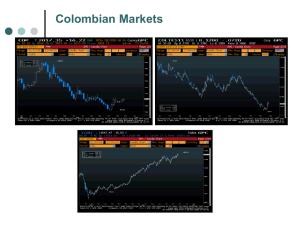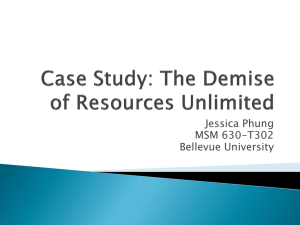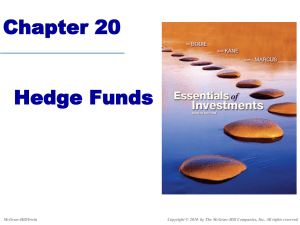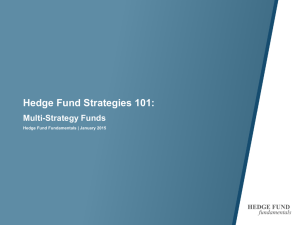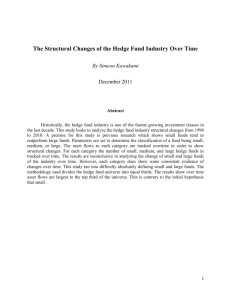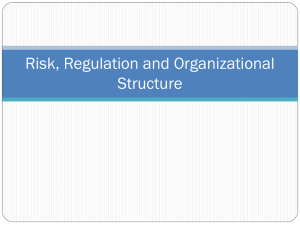Hedge Funds - Holy Family University
advertisement
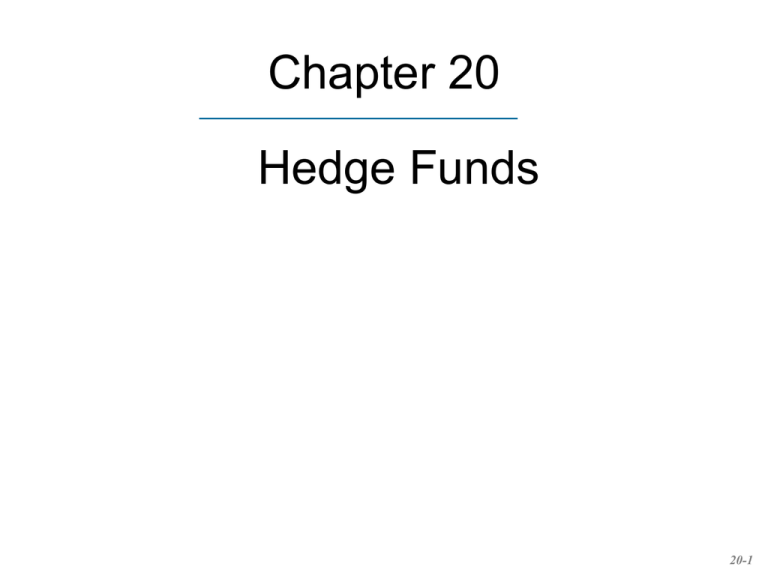
Chapter 20 Hedge Funds 20-1 Hedge Funds vs Mutual Funds Transparency Mutual Funds Hedge Funds • Public info on portfolio composition • Info provided only to investors • Unlimited • < 100, high dollar minimums Investors Strategies • Must adhere to prospectus, limited short selling & leverage, limited derivatives usage • No limitations 20-2 Hedge Funds vs Mutual Funds Mutual Funds Liquidity Fees Hedge Funds • Multiple year lock • Redeem up periods typical shares on demand • Fixed percentage • Fixed of assets; typically percentage of 1% to 2% plus assets; incentive fee = typically 0.5% 20% of gains to 2% above threshold return 20-3 Directional & Non-Directional Strategies • Directional strategies – A position that benefits if one sector of the market outperforms another, an unhedged bet on a price movement – For example, buy bonds in anticipation of an interest rate decline 20-4 Directional & Non-Directional Strategies • Non-Directional strategies – Attempt to arbitrage a perceived mispricing • Typically a risky arbitrage • For example, spread between corporates and Treasuries is believed to be too large so you buy the corporates and short the Treasuries. • Market neutral with respect to overall interest rates. • Which type of strategy is riskier, Directional or Non-Directional? 20-5 Hedge Fund Styles Insert Table 20.1 here or http://www.hedgeworld.com/education/ind ex.cgi?page=hedge_fund_styles or http://www.magnum.com/About.aspx?Row ID=15 20-6 Statistical Arbitrage • Statistical arbitrage – Uses quantitative math models and often automated trading strategies that attempt to identify small mispricings in multiple securities. – Involves placing small bets in hundreds of different securities for short holding periods (minutes). – Require fast trading and low transactions costs. – “Pairs Trading” • Find two ‘twin’ stocks; short the high priced one and buy the low priced one. • Do this for many pairs, rely on law of large numbers. 20-7 Fundamental risk and mispriced securities • Problem: – A fund finds a positive alpha stock but expects the overall market to fall. • Solution: – Buy the stock and sell stock index futures to drive effective stock beta to zero, – This is a ‘market neutral’ pure play, – When combined with a passive strategy this is called alpha transfer. 20-8 Pure Play Example β 1.20; α 0.02; rf 0.01;S & P500 Index 800, futuresmultiplier 250 Starting Dollar Value $1,000,000 Hedged End Value $1,030,000 $1,000,000e $1,030,000 $1,000,000 Re turn .03 $1,000,000 .03 rf .01 rf (.02 ) We have captured the alpha and hedged out the market risk. (Unsystematic risk remains.) 20-9 Style and Factor Loadings • Many fund strategies are directional bets and may be evaluated with style analysis (see Chapter 18), • Directional investments will have nonzero betas, called “factor loadings,” • Typical factors may include exposure to stock markets, interest rates, credit conditions and foreign exchange. 20-10 20.5 Performance Measurement for Hedge Funds 20-11 Fund Alphas and Sharpe Ratios • Hasanhodzic and Lo (2007) find that style adjusted alphas and Sharpe ratios are significantly greater than the measures for the S&P500 for a large sample of hedge funds. Changing nowadays! • This implies: – Hedge fund managers are highly skilled OR – Aragon (2007) controls for illiquidity of hedge funds with lockup periods and other redemption restrictions and finds the alphas become insignificant. – Related work by Sadka (2008) shows that hedge funds must generate significantly larger returns to offset liquidity risk. 20-12 Fund Performance and Survivorship Bias • Survivorship bias is a problem in performance measurement of risky hedge funds – Those that don’t survive don’t report results that are used in estimating average performance. • Backfill bias – Hedge funds report returns to publishers only if they choose to. 20-13 Tail Events and Performance • Many hedge funds employ mathematical models that rely on near term historical price data. • Their strategies’ performance takes the form of a written put option. – Writing a put option is a way to capture the put premium and is appropriate in low volatility markets. – In high volatility markets they face large losses, out of pocket if markets fall and large opportunity costs if markets rise. • When the more rare large market moves (tail events) do occur hedge fund performance is not likely to appear as strong and they may suffer large losses. 20-14 Evaluating Hedge Fund Fees which is very high but coming down recently • Typical hedge fund fees includes a fixed management fee between 1% and 2% of assets plus an incentive fee usually equal to 20% or more of investment profits above a benchmark performance return. • Incentive fees are analogous to call options on the portfolio with a strike price equal to the current portfolio value x (1+ benchmark return). 20-15 Black-Scholes Value of Incentive Fee • • • • • • • Suppose a hedge fund’s returns have an annual =30% The annual incentive fee is 20% of the return over the risk free money market rate. The fund has a net asset value of $100 per share and the annual risk free rate is 5%. The implicit exercise price of the incentive fee is $100 x 1.05 = $105 The Black-Scholes value of a call option with S0 = $100, X = $105, =30% ,T = 1 year, & rf = LN 1.05 = 4.88% is $11.92. (See Chapter 16 for details on option prices) Incentive fee is equal to only 20% of the value over $105 so the current value of the incentive fee = 20% x $11.92 = $2.38 per share or 2.38% of net asset value. Coupled with 2% management fee yields total fees of 4.38%, much larger than mutual funds. 20-16 Fees and the High Water Mark • High Water Mark – Funds that experience losses in one period may not be able to charge any incentive fee until the prior period losses are regained. – This complicates estimating the value of the incentive. – Gives managers an incentive to close the fund and start over when large losses occur. 20-17 Funds of funds • Funds of funds invest in one or more other hedge funds. – Serve as ‘feeder funds’ to ultimate hedge fund – Allows investors to easily diversify across hedge funds. – May be a bad deal because of extra layer of fees. – Earned a bad reputation when it became apparent that many large fund of funds were major investors in Bernard Madoff’s $50 billion Ponzi scheme. 20-18


